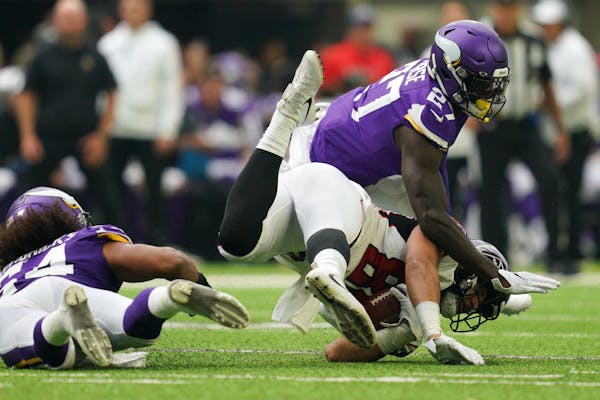Three players who stood out
• Xavier Rhodes: Since the Vikings started asking him to shadow opposing teams' top receivers, the cornerback has made a habit of slowing down some of the game's top offensive threats. But there might not be any Pro Bowl receiver against whom Rhodes has been as effective as the Falcons' Julio Jones. On Sunday, Jones caught only six of his 11 targets for 31 yards, posting two of his catches and his touchdown against Mark Fields after the Vikings were already resting starters.
• Everson Griffen: The 31-year-old defensive end showed early signs of a return to form, posting a sack and providing a more consistent force against the run than he did last year. That second point is especially important, given how good of a run defender Griffen has been over the years and how teams started to run the ball more in his direction at times last season.
• Anthony Harris: Harris' two interceptions highlighted what the Vikings like about him — he was in the right place to make a play on Jones in the first quarter, when he converged on a high throw and took it away from the receiver, and he made an exceptional play to snatch Matt Ryan's ill-fated third-quarter throw in the back corner of the end zone, almost looking like the receiver Ryan had intended to hit after Luke Stocker stopped his route.
A trend to watch
Irv Smith Jr./C.J. Ham: The Vikings made frequent use of both players Sunday, though Smith was employed largely as a blocker; the second-round pick didn't have a catch in his first NFL regular-season game, in which he played 26 snaps. But the Vikings were able to make use of the tight end as a slot receiver on a number of occasions, including on Dalvin Cook's 22-yard run in the second quarter, when Smith had a nice downfield block after Cook stepped through the initial hole between right guard Josh Kline and right tackle Brian O'Neill. It figures to be a busier year for Ham than it was in 2018, when the fullback only reached 20 offensive snaps in one game. On Sunday, he played 22 snaps and carved out a key role as a lead blocker on several of the Vikings' big runs.
And one big question
What will "balance" ultimately look like for the Vikings offense? We have heard coach Mike Zimmer talk about the need for more balance on offense since last Nov. 18, when the Vikings ran 14 times for 22 yards in a 25-20 loss to the Bears, and it's clear the 2019 Vikings have coalesced around the coach's desire to run the ball more often. But after the Vikings ran it 36 times and asked quarterback Kirk Cousins to drop back 11 times on Sunday, even Zimmer seemed reticent about calling this the blueprint for the 2019 Vikings. "I never thought we'd throw it 10 times, but the score of the game dictated that," he said Sunday — in response to the "blueprint" question.
The Vikings aren't going to be sitting on 28-0 leads every week, and they will have to unpack more of their offensive playbook at some point, possibly as soon as Sunday at Green Bay, as they face a Packers team that gave up only 46 rushing yards to the Bears. The guess here is the Vikings will still end up throwing the ball between 55 and 60% of the time during the season, and it's overly simplistic to equate "balance" with running on every play — especially when three of the team's four highest-paid players are the quarterback and his top two receivers. They will look for a running game that can take more pressure off Cousins, but they will also look to create consistently clean pockets from which he can work. As soon as Sunday, they could have to achieve something closer to true "balance" to succeed on offense.
BEN GOESSLING
The Timberwolves coaching staff, empowered by Finch and energized by chemistry, is a true asset

Trail section at one of Minnesota's most iconic spots closing for rehab

Will 'shotgun only' zone for deer in southern Minnesota be abolished?

